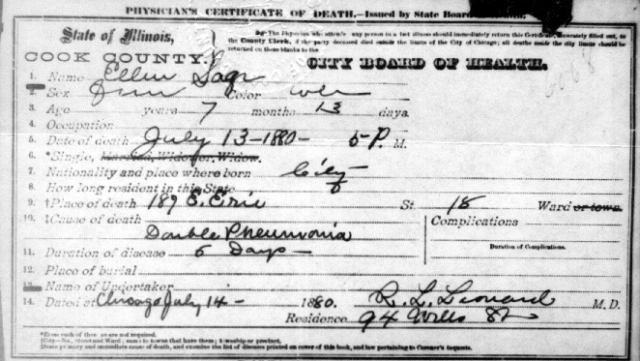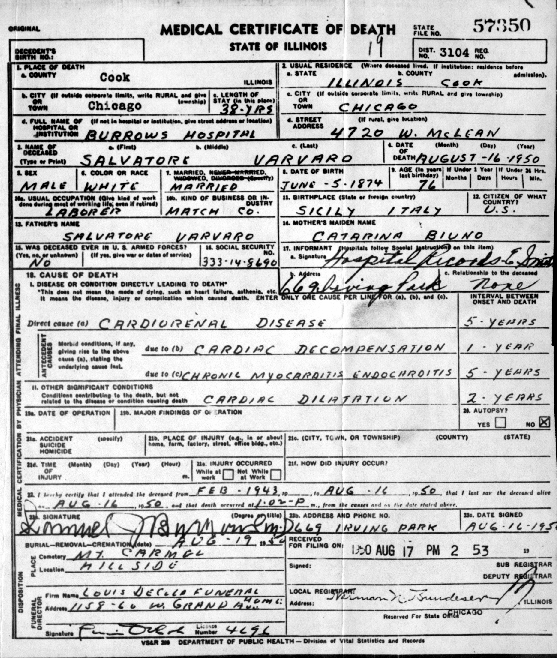Last month we looked at birth certificates and what you can learn from them. This month, we follow with marriage licenses and death certificates. Why do we cram two types of documents into one column? Well, frankly, the Cook County marriage license has so little data that it would be the world’s shortest column!
The fact is that Cook County created a format for the marriage license in 1871, and at least as of 1964 the format was relatively the same. The paper is split into two halves. The top half lists the name of the groom and his age, and the bride and her, ahem, age, too. Sorry folks, but I have found quite a few instances where the bride actually grew older in order to get married. In a few cases, the grooms did too! On some licenses, you might see the approval of the father of the bride to allow her to marry under age. Below the names, the county clerk dated and signed the license.
The bottom half was to be filled out by the priest, minister, rabbi, judge, or whomever solemnized the marriage. That person signed their name, and filled in the date and location where the marriage took place.
So what’s missing? Oh, I don’t know. How about the names of their parents? How about the birth dates of the bride and groom? How about the birthplaces? There is so much data that ought to be there. Unlike for births and deaths, the format for the marriage license barely changed over almost a hundred years.
Now let’s talk about death certificates. The early documents start with the basics: Name, sex, color, age, occupation, date and time of death. The document continues with the marital status, birthplace (usually just “city,” or the country of birth), length of residence in Illinois, address of death, Chicago ward, cause of death, complications, duration of disease, place of burial, name of the undertaker, name and address of the physician, and the date of the certificate.
So, with all that, what do we really know? We can trust most of the data at this point, with the exception of the age (always suspect), and the cause of death (medicine was pretty weak in those days).
This format stayed until the mid 1890s, when they changed the look of the form but basically recorded the same info. The top of this new form asked for the name of a hospital, or the address where the death occurred.
Around 1910, the form changed again, asking a lot more about residency: “how long at present address,” “how long in this state,” “how long in US if foreign born.” For the first time, the parents’ names appear on the death certificate. Instead of “age,” it finally asks for the date of birth. There is a section for “current occupation” and a range of years, and a “former occupation” and range of years. So far, I haven’t seen that section filled out completely.
In 1916, they rearranged the form once again and added the parents’ birthplaces. Sometimes they listed the city but frequently they came from a country called “Unknown.” (Not sure if “Unknown” was a monarchy or democracy!” They also specifically asked for the city or town of birth of the deceased, and it seems like many of them came from the Republic of Unknown …
They also kept track of who the informant was, which is critical. If the informant was “hospital records,” or “Sister Mary John Purpura” then you should worry that the data on the family may not be 100 percent accurate. It isn’t perfect even if the informant is the widow(er) of the deceased. You can check the death certificate for the length of time of the illness. It is an unfortunate correlation that if the person spent a long time in the hospital, the details are more accurate. A person who died instantly in an accident or of a heart attack may have less accurate details because of the shock of the event.
By 1950, they shifted a few fields around. They now ask for the social security number, which is handy to have on death records that pre-date the old Social Security Death Index (that started in 1962) They also asked if the deceased was in the armed forces, which is a tip off to go get their draft or enlistment applications. Keep an eye out for a field #12 “Citizen of what country.” If they were born in Italy or elsewhere, and they are US citizens, you should try to find their naturalization petition.
Although each state and even some cities have their own formats, the Cook County death certificate stayed, well, almost the same into the 2000s. The latest format I have seen contains some intriguing fields:
“If Hospital, indicate DOA, E.R., or inpatient”
“Name of surviving spouse” which is left blank if the person who died was widowed….Why don’t they just list the deceased spouses’ name? You left room for it on the form! (end of rant)
“Education: Elementary (# of years) and College (# of years)”
“Residence: inside city? Y/N” This is for those areas that were unincorprated at the time
“Of hispanic origin: If Yes specify Cuban, Mexican, Puerto Rican etc.”
“Natural, Accident, Homicide, Suicide, Undetermined”
“Date of Injury that contribued to death”
“Injury at work? Where was injury?”
“If female, was there a pregnancy in the past 3 months?”
A lot more data than 1900, eh? My only advise to you when working with these is to A) use every piece of data they give you, to find other documents; and B) mark your data in your family tree when it was found in the death certificate. Use the certificate as the “Source.” It is very important that if you have a birth date of 1904, if the source of the birth is the 1904 birth certificate or the 2002 death certificate.
For example, if you have the death certificate of your cousin’s first wife, and you need her birth certificate, you can search familysearch by her parents names. The year may be inexact, but you find the right person and you can then source the birth date from the newly found birth certificate.
Another interesting side project is to plot residences on an on-line map, plus the hospitals.
Any questions, suggestions, or comments, please e-mail me at italianroots@comcast.net and put “Fra Noi” in the subject.
 Fra Noi Embrace Your Inner Italian
Fra Noi Embrace Your Inner Italian










